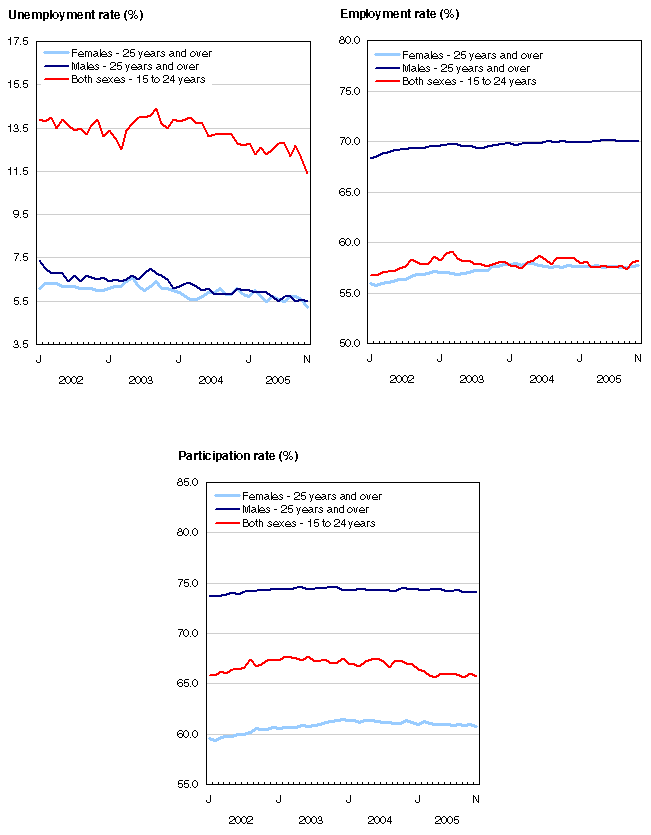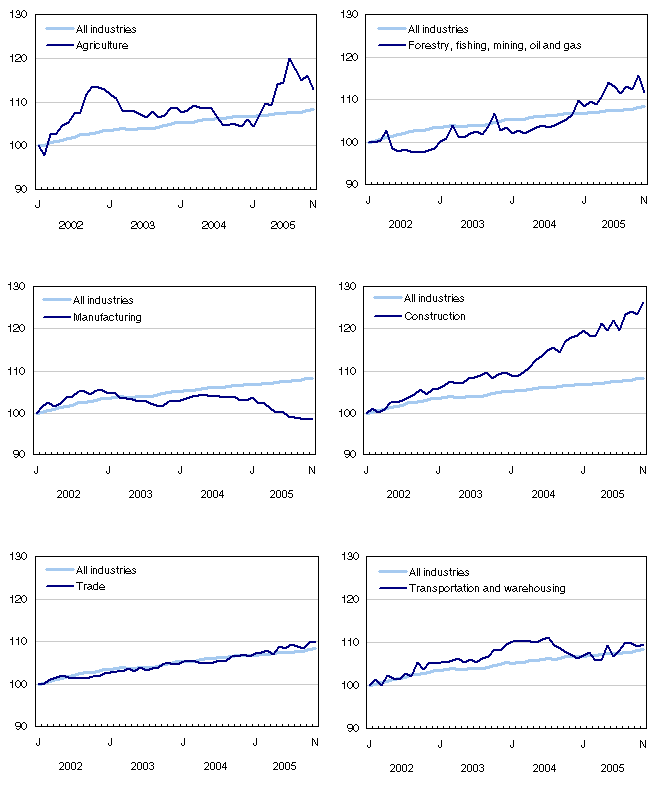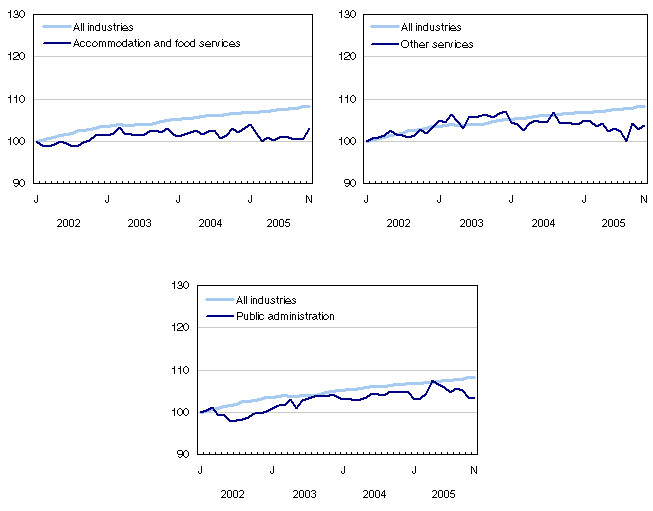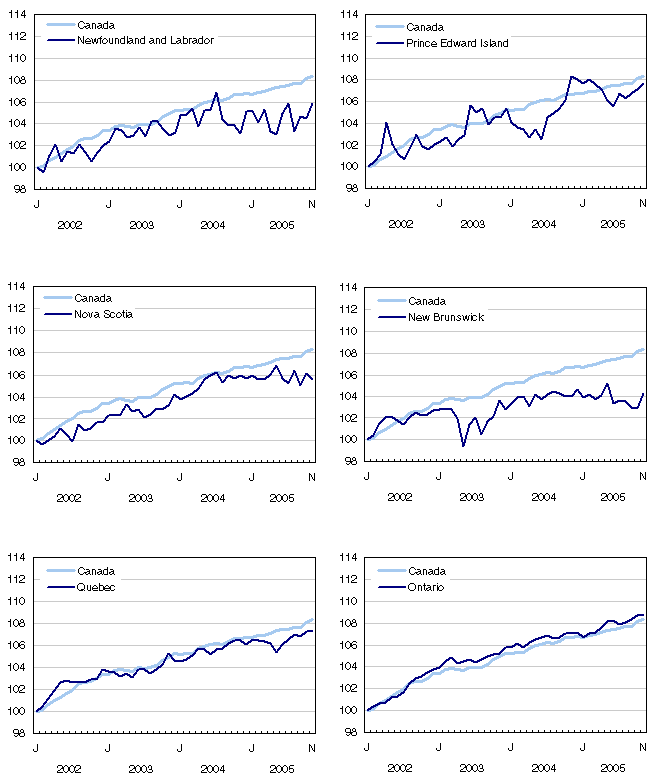
















 |
|
 |                |
Information identified as archived is provided for reference, research or recordkeeping purposes. It is not subject to the Government of Canada Web Standards and has not been altered or updated since it was archived. Please "contact us" to request a format other than those available.
| Labour force information Not for release before 7 A.M. E.S.T. Friday, December 2, 2005 Week ending November 12, 2005 Analysis — November 2005 Spurred by full-time gains, employment increased by 31,000 in November. This brings gains over the last 12 months to 250,000 (+1.6%). In November, the unemployment rate fell 0.2 percentage points to 6.4%, the lowest rate in over three decades. Average hourly wages in November were 3.9% higher than 12 months ago, well above the 2.6% year-over-year increase in October’s Consumer Price Index. Alberta saw the largest increase in average hourly wages with an increase of 6.7% from a year ago. With all of the year-over-year increase in employment coming from full time, the total actual hours worked in the economy were up 2.0% in the last 12 months. Unemployment rate for women hits 30-year low In November, the unemployment rate for adult women (aged 25 and over) fell by 0.4 percentage points to 5.2%, their lowest rate in the last 30 years. A small increase in employment and a drop in the number of adult women in the labour force contributed to the decline in their unemployment rate. Among adult women, full-time work increased by 36,000 in November, while part time declined by 24,000. In the past 12 months, the number of full-time jobs for women has increased by 3.1%, while part-time has declined by 3.5%. The youth unemployment rate declined in November, falling to 11.4% from 12.1% in October. Despite the lower unemployment rate, employment growth for youths has been lackluster, increasing by a very moderate 0.8% in the past 12 months. Over this same period, the participation rate among youths has declined by 1.3 percentage points to 65.7% in November. More jobs in construction Employment growth in November was led by a gain of 24,000 in construction, primarily in Ontario and British Columbia. Business, building and other support services also added jobs in November, employing 12,000 additional workers. In the past year, employment in construction has grown by 7.2% (+71,000) and by 6.7% (+43,000) in the business, building and other support services industry. Accommodation and food services also made strong employment gains in November (+23,000), primarily in full-service restaurants. Even with this increase, employment growth in the industry has been weak over the past year, rising by 1.0% or 10,000. In educational services, employment increased by 12,000 in November, mostly in primary and secondary education. This brings gains over the past 12 months to 8.2% (+86,000), the fastest employment growth rate of all industries. Much of the added employment in education has been in Ontario and Quebec. In November, employment declined by 17,000 in the health care and social assistance industry. While employment in health care facilities remained higher than a year ago, there were fewer people working in social assistance and nursing homes, leaving employment in the industry unchanged from a year ago. Employment declined by 15,000 in finance, insurance, real estate and leasing in November, primarily in Quebec. Nevertheless, employment in the industry remained virtually unchanged from 12 months ago. Employment in the natural resources industry dropped 11,000 in November. However, the number of people working in natural resources has increased by 4.9% (+14,000) in the past year, driven by gains in Alberta. Employment continues to rise in British Columbia In November, employment increased by 18,000 in British Columbia, bringing the unemployment rate down to 4.9%, the lowest rate in over three decades. Jobs were added in a number of industries. Since November of last year, employment in the province has grown by 4.3% (+90,000), the highest growth rate of all the provinces. Employment in New Brunswick increased by 5,000 in November, all full-time. At the same time, the number of people who were looking for work fell, pushing the unemployment rate in the province down 1.5 percentage points to 9.5%. In Newfoundland and Labrador, employment rose by 3,000 in November leaving employment in the province 2.6% above the level of a year ago. In November, the increase was driven by a jump in manufacturing. In November, employment rose by 3,000 in Manitoba, causing the province’s unemployment rate to edge down 0.2 percentage points to 4.2%, the lowest since April 1976. A gain of 21,000 full-time jobs in Alberta was offset by a similar decline in part-time leaving overall employment unchanged in November. Full-time employment in the province has increased by 55,000 (+3.8%) in the past twelve months while part-time employment has declined by 27,000 (-8.3%). In November, employment in the natural resources industry fell but was still 6.2% above the level of a year ago. Employment also increased in November in accommodation and food services; however, 16,000 (-12.8%) fewer Albertans were working in the industry compared to a year earlier. In Ontario, the unemployment rate edged down 0.3 percentage points to 6.1% in November, as fewer people were looking for work. Although unchanged in November, in the past year, employment in the province has grown at a moderate rate of 1.6% (+101,000). Over the past year, employment growth in the province has been particularly strong in both educational services (+53,000) and construction (+40,000). Despite little change in employment in Quebec, the unemployment rate fell by 0.3 percentage points to 8.0% in November. Declines in finance, insurance, real estate and leasing and health care and social assistance were offset by increases in other services and information, culture and recreation. Employment was little changed in the other provinces.
Chart 2

Chart 3

Chart 4

Chart 5

Chart 6

Chart 7

Chart 8

|
|
|
|